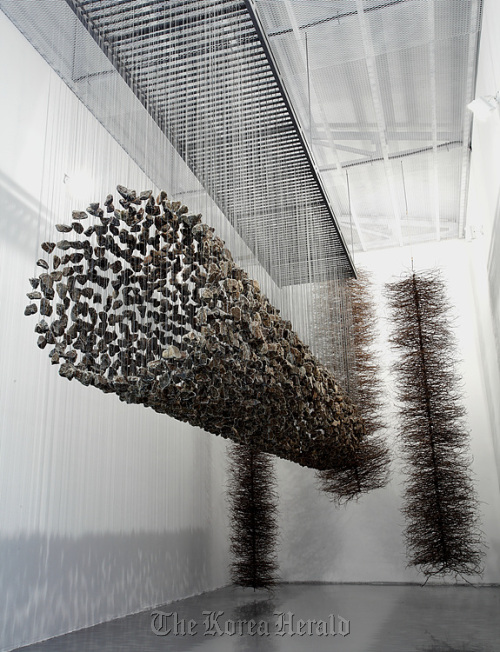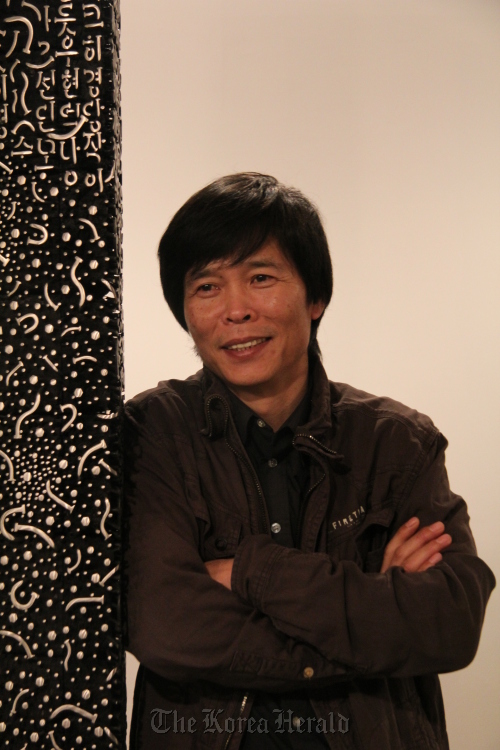
Artist Lee Jae-hyo showcases sculptures close to nature at Sungkok Art Museum
What could have ended up in the trash or at a hardware store at best turns into art ― extremely delicate, even, ― when touched by Lee Jae-hyo’s finger tips.
The South Korean artist slices nails and hammers them until they are shiny and smooth, and creates symmetrical sculptures by putting thousands of them together. Some of his other materials of choice are wood and stones, which he works in similar ways.
Seeing his works first hand, one would soon realize that the not-so-accessible price of the artworks ― Lee is a blue chip artist ― may stem from the cost of his labor, not the materials.
Even those who have never heard of him before would have surely walked by one of his works at some point ― his works are found in most of the major hotels in Seoul. But save the effort to visit the hotels; his representative works are clustered at the large-scale solo exhibition underway at Sungkok Art Museum through May 27.
The museum seems to be one of the best places to show his nature-themed works as it is located in a strangely removed place surrounded by nature in the heart of Seoul.
The retrospective show “Working with Nature” looks back on the last 20 years of Lee’s career. The exhibits range from drawings he did while attending Hongik University to his 2012 installation works.
What could have ended up in the trash or at a hardware store at best turns into art ― extremely delicate, even, ― when touched by Lee Jae-hyo’s finger tips.
The South Korean artist slices nails and hammers them until they are shiny and smooth, and creates symmetrical sculptures by putting thousands of them together. Some of his other materials of choice are wood and stones, which he works in similar ways.
Seeing his works first hand, one would soon realize that the not-so-accessible price of the artworks ― Lee is a blue chip artist ― may stem from the cost of his labor, not the materials.
Even those who have never heard of him before would have surely walked by one of his works at some point ― his works are found in most of the major hotels in Seoul. But save the effort to visit the hotels; his representative works are clustered at the large-scale solo exhibition underway at Sungkok Art Museum through May 27.
The museum seems to be one of the best places to show his nature-themed works as it is located in a strangely removed place surrounded by nature in the heart of Seoul.
The retrospective show “Working with Nature” looks back on the last 20 years of Lee’s career. The exhibits range from drawings he did while attending Hongik University to his 2012 installation works.

“The reason I use materials close to nature is because they are familiar to people. Of course, there are many other prettier and shinier materials than nails but they were so closely used by human beings forever that they almost became nature,” Lee told the press last week.
He said that he tries to maximize the original feeling of the materials, twisting them only a little. Hanging weighty stones from the ceiling or showing the insides of a nail or a piece of wood is what he does.
To the disappointment of some people, however, he does not hammer on every single nail or hang up every single stone. He has a staff about 30 who help him out at his studio/home located in Jipyeong, Gyeonggi Province.
“My works gain strength when they get bigger. So I started to hire staff about seven to eight years ago. Only two among the staff have studied art, and the rest used to be farmers in the town. I am more comfortable working with them because they rely on me completely while art students voice their thoughts,” said the artist.
His works lie on a boundary between art and design ― they are found at exhibitions in prestigious galleries but also at design art fairs. He said that it does not matter how people take his work.
“At first, I made the sculptures in a sphere-form to tell stories everyone can empathize with, instead of simply telling my story. And when I tried cutting them in half for a change, people took them and used them as tables. I regard my works as art, but it does not matter how people use it. These days I think that maybe if they use them as tables, they would look at it and talk about it more often,” said Lee.
Wanting people to feel the work instead of being forced to accept the artist’s story, he leaves his works untitled, he added.
Though made with natural materials, the artworks can last almost forever with the humidity level kept just right, said Lee. In terms of wood, he mostly uses chestnut trees, Korean nut trees and larches which are common and do not split easily.
“I don’t know what kind of other materials I would use next. If I come across something I like, I might use it, and if I don’t then I won’t. I can’t really predict,” said Lee.
The exhibition runs through May 27 at Sungkok Art Museum in central Seoul. Tickets range from 4,000 won to 5,000 won. Museum is closed on Monday. For more information, call (02) 737-7650 or visit www.sungkokmuseum.com.
By Park Min-young (claire@heraldcorp.com)
-
Articles by Korea Herald



![[Herald Interview] 'Amid aging population, Korea to invite more young professionals from overseas'](http://res.heraldm.com/phpwas/restmb_idxmake.php?idx=644&simg=/content/image/2024/04/24/20240424050844_0.jpg&u=20240424200058)













![[KH Explains] Korean shipbuilding stocks rally: Real growth or bubble?](http://res.heraldm.com/phpwas/restmb_idxmake.php?idx=652&simg=/content/image/2024/04/25/20240425050656_0.jpg&u=)

